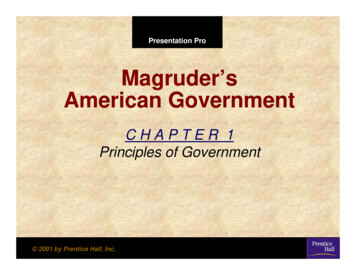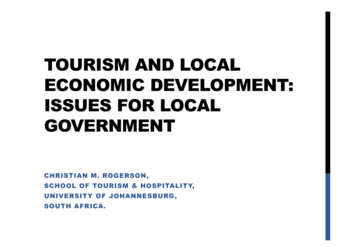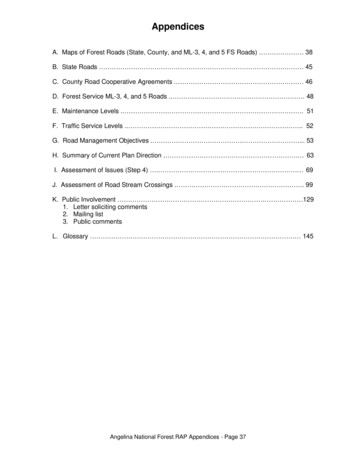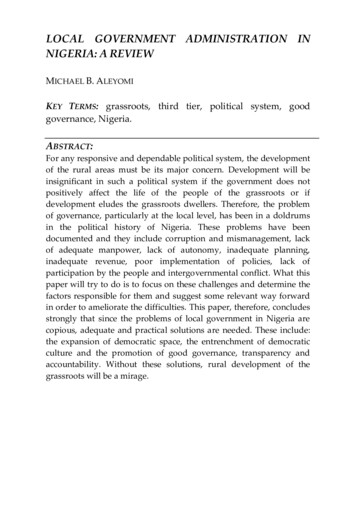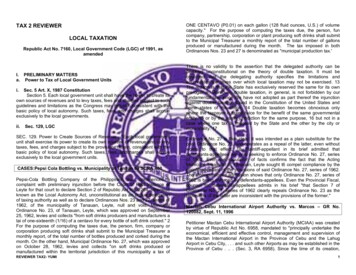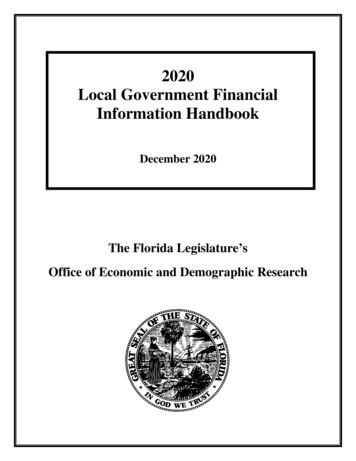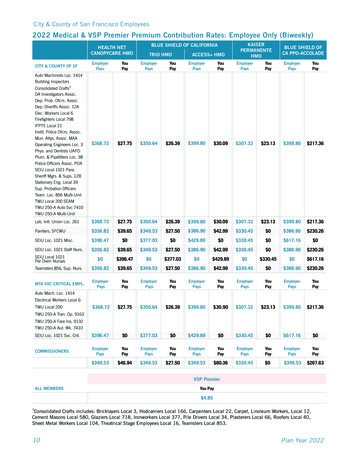
Transcription
THE LOCAL GOVERNMENT SYSTEM IN ghanaGHANASUMMARYGhana is a constitutional republic with two spheres of government: national andlocal. Local government is enshrined in the constitution, as is decentralisation, andthe main relevant legislation is the Local Government Act 2016 (Act 936). The countryis divided into ten administrative units or regions, each headed by a regional ministerappointed by the president. There are three types of assemblies at the higher levels oflocal government: metropolitan, municipal and district. There are also sub-structuresthat do not hold any legislative or rating powers and undertake activities delegatedto them by the assemblies: sub-metropolitan, district, urban, town, zonal and areacouncils and unit committees. Following the 2015 local elections 4.7% (276/5,930) ofcouncillors in Ghana were women, down from 6.7% in 2010. The district assembliesare responsible for the setting and collecting of local revenue. There are also numerousgrants transferred from national to local government, the most important of which isthe District Assemblies Common Fund which provides for an allocation of no less than5% of total government revenue to district assemblies annually. The assemblies areresponsible for the overall development of the district, including the promotion of localeconomic development, basic education and public health, environmental protectionand sanitation, and the improvement and management of human settlements.1. NATIONAL GOVERNMENTGhana is a constitutional republic with aunicameral parliament.14.1 The head of stateand government is the executive president,who is directly elected for a maximumof two four-year terms by universal adultsuffrage, with a minimum of 50% of thevote. The 275 members of parliament (MPs)are directly elected by universal suffragefrom single-seat constituencies under thefirst-past-the-post system for four-yearterms. The cabinet, known as the Councilof Ministers, is nominated by the presidentand approved by parliament. There is alsoan advisory hereditary House of Chiefs.The president has an appointed advisorybody, the Council of State, made up of 25prominent citizens. Of these 25, there mustbe one member who has held each of thefollowing positions: chief justice, chief ofdefence, staff inspector-general of police,and president of the national House ofChiefs. One further representative memberis indirectly elected from each of the tenregions by an electoral college made upof two nominated councillors from eachdistrict within the region; and the final 11members are appointed by the president.2.2 Main legislative textsThe main legislative texts relating to localgovernment in Ghana are:Civil Service Law 1993 (PNDCL 327)National Development Planning(System) Act 1994 (Act 480)National Development PlanningCommission Act 1994 (Act 479)Institute of Local GovernmentStudies Act 2003 (Act 647)nn Internal Audit Agency Act 2003 (658)nn Local Government (Departments ofDistrict Assemblies) CommencementInstrument 2009 (LI 1961).nn Local Government Act 2016 (Act 963)with Amendment (Act 940)16.2bnn Public Financial Management Act2016 (Act 921)nn Land Use and Spatial Planning Act2016 (Act 925)nn National Development Planning(System) Regulation 2016 LI 22322. LEGAL BASIS FORLOCAL GOVERNMENT2.1 Constitutional provisionsLocal government is enshrined inArticle 241/3, as is decentralisation(Article 240/2).16.2a Article 35 requiresthe state ‘to take appropriate measuresto ensure administrative and financialdecentralisation and to give opportunitiesto people to participate in decisionmaking at every level in national lifeand government’. The constitution alsoestablishes the District AssembliesCommon Fund (DACF) and provides fornot less than 5% of total governmentrevenues to be paid into it for use bydistrict assmeblies for development (seesection 9.3.1 for more details).2.3 Proposed legislative changesThe government is undertaking a reviewof local government, which includesa commitment to introduce directelection of metropolitan, municipal anddistrict chief executives (MMDCEs). Thisproposal will be subject to a referendumon the constitutional changesrequired.16.2ewww.clgf.org.uk/ghanaA decentralisation policy framework wasadopted in 201016.2c and a local economicdevelopment policy in 2013.16.2d2.4 Traditional leadershipTraditional leaders are accordedprominent roles in Ghanaian localgovernment, in acknowledgement thata number of district assembly areas havebeen carved out of areas of jurisdictionof traditional authorities. Nine per cent ofassembly seats are reserved for traditionalKEY FACTSPOPULATION (2020 estimate):31,155,262AREA (UN 2006):238,533 sq kmCAPITAL:AccraCURRENCY:Ghana cedi (GHS)HEAD OF STATE AND GOVERNMENT:President Nana Akufo-AddoFORM OF GOVERNMENT:constitutional republicPARLIAMENTARY SYSTEM:unicameralSTATE STRUCTURE:unitaryLANGUAGES:English (official); Akan, Dagaare, Dagbani,Dangme, Ewe, Ga, Gonja, Kasem, Nzema(government-sponsored)NATIONAL ELECTIONS:last: 2016; turnout: 69.3%; next: 2020WOMEN IN PARLIAMENT (2016):12.7%LOCAL ELECTIONS:last: 2019; turnout: data unavailable atthe time of publication; next: 2023WOMEN COUNCILLORS:4.7% (2015)LOCAL GOVERNMENT EXPENDITUREas a percentage of total governmentexpenditure 2020:1.8%73
THE LOCAL GOVERNMENT SYSTEM IN ghanaTable 16.1a Distribution of councils and n/a3,318,85356.6Greater Accra2234n/an/an/an/an/a5,055,8839.5North avannah016n/an/an/an/an/a594,712naUpper East0312n/an/an/an/an/a1,302,71879.0Upper 60naWestern North036n/an/an/an/an/a949,094naTOTAL 106111143108626 16,000RegionNumber of assembliesNumber of sub-districtsMetropolitanMunicipalDistrictUrban districtAhafo033n/aAshanti11824Bono05Bono East0Central34Town25030,955,201% rural(2010 Census)na39.449.1Source: MLGRD communication with CLGF, and 2010 Census16.3a and population estimates 2015–2016.3bleaders and there are also seats reservedfor them on the RCCs (see section 3.2).Traditional rulers beat the gong forassemblies to ensure maximumattendance during communal labour;they also contribute to the resources ofassemblies through land revenue, helpto preserve customs and culture, declareor interpret customary laws and liaisebetween local communities and localgovernment units.2.5 National urban policyThe National Urban Policy Framework2012 and Action plan launched in 2013.The policy provides the framewrk forcoordination among urban developmentstakeholders and facilitates a multisectoral approach. It also supportscooperation between national and localgovernments to allocate the necessaryresources for public and privateactivities.14.2f3. STRUCTURE OF LOCAL GOVERNMENT3.1 Local government within the stateThe assemblies are the highest units oflocal government. There are three types:six metropolitan, 56 municipal and154 district assemblies. There are alsosub-district political and administrativestructures which are subordinate bodiesof the assemblies. These include sub-74metropolitan, district, urban, town, zonaland area councils, and unit committees.3.2 Ministerial oversightThe Ministry of Local Governmentand Rural Development (MLGRD)16.3cis responsible for local government,including:nn local government policynn monitoring the effectiveness of localgovernment and the decentralisationprocessnn advising government on localgovernment issuesnn promoting and administering localgovernment training institutionsnn acting in an advisory capacity todistrict assemblies and approvingtheir by-laws.The supervisory role of the MLGRD hasin some cases led to the suspensionof district assemblies where financialirregularities were discovered.However, the power to suspendassemblies is vested in the president.Ghana also has a network of regionalcoordinating councils (RCCs), whichcomprise representatives from thedistrict assemblies and traditionalauthorities in the region, and are chairedby regional ministers.3.3 Council typesThe metropolitan assemblies coverurban areas with populations over250,000. Municipal assemblies aresingle-town councils with populationsof 95,000 or more. The districtassemblies cover a wider geographicalarea combining rural areas and smalltowns. The metropolitan structure isfour-tiered while the municipal anddistrict assemblies have a three-tieredsystem. The lower tiers are called substructures and comprise town, area,zone and unit.)16.3d3.3.1 Assemblies: District, metropolitanand municipal assemblies all have thesame internal political structures. Thepolitical–administrative head in eachdistrict is the district chief executive(DCE), a post similar to an executivemayor. The DCE is responsible for theexecutive and administrative functionsof the district assembly. S/he is also‘the chief representative of the nationalgovernment in the district’.Seventy per cent of members of theassembly are elected by universal adultsuffrage, whilst 30% are appointedby the president on the basis of theirexperience and specialised expertise.MPs representing constituencies ineach district are ex-officio members ofthe assembly. The district assembly isrequired to meet at least three timeswww.clgf.org.uk/ghana
THE LOCAL GOVERNMENT SYSTEM IN ghanaCOUNTRY PROFILE 20194.2 Voting systemElections to all tiers of local governmentare held concurrently every four yearsand cannot be held within six months ofnational elections.Elections to the district assembliesare conducted by secret ballot usingthe first-past-the-post system. Allelected assembly members representsingle-member wards and must standindependently of any political party. Toqualify to be elected, individuals must becitizens of Ghana, 18 years old, ordinarilyresident in the district and paid-up ontheir taxes and rates.each year. It is led by an executivecommittee comprising not more thanone-third of all assembly members, whichreports to the assembly. The executivecommittee is indirectly elected by theassembly in full session and is open to allthe councillors except the chairperson.The executive committee normallyhas a number of sub-committees –development planning, social services,works, justice and security, financeand admin i stration – which makerecommendations to the executivecommittee. With the exception of thechairperson, all assembly membersmust sit on at least one sub-committee.The assemblies have full discretion toestablish further committees as they seefit. They are also empowered to establishcommittees jointly with other assembliesfor any project in which they hold a jointinterest. Such joint committees mustreport to the executive committees of thedistricts involved.4.3 Elected representativesAssembly members serve a four-yearterm and can stand for unlimited reelection. Assembly members may berecalled by the electorate, though theprocedure is relatively complex as follows:a petition signed by 25% of the districtelectorate triggers a referendum, 40%of the electorate must participate, anda 60% majority of ballots cast must bein favour of the removal of the assemblymember, in order to make the recalllegally binding. Appointed members mayalso be removed through a mechanismin which the district assembly makesthe case to the president. The DCE hasa four-year term of office and he orshe may not serve for more than twoconsecutive terms. The DCE is nominatedby the president and must receive theapproval of two-thirds of the assembly.The presiding member of the districtassembly – the chairperson – is indirectlyelected by the district assembly and mustcommand a two-thirds majority in orderto take office.3.3.2 Town, area, zonal and unitcommittees: These sub-structures do nothold any legislative or rating powers. Thetown/area/zonal councils are composed offive representatives of the district assembly,ten representatives of unit committeesin the area and five persons appointedby the government. They are delegatedtasks by the assemblies. The intermediatetier councils and unit committees arecomposed of representatives of the districtassemblies. Similarly the unit committees,the lowest level of the structure, haveboth elected and appointed members.There are around 16,000 unit committeescountrywide.4. ELECTIONSElections are overseen by the ElectoralCommission416.4a5.2 ICT use in citizen engagementMost districts have active websitesthrough which to engage their citizens.14.56. ORGANISED LOCAL GOVERNMENTThe National Association of LocalAuthorities in Ghana14.6 (NALAG) isthe local government association.Membership is voluntary but all districtassemblies have opted to be members.4.4 Women’s representationThe proportion of women councillorsfollowing the 2015 local election was 4.7%(276/5,930), down from 6.7% following the2010 elections, the lowest since the turn ofthe millenium (see table 14.1b). The currentproportion of DCE’s that are women isnot known; however it was 5.8% (8/138) in2006.4.1 Recent local electionsLocal elections were last held in 2015,with the next elections scheduled forNovember 2019.14.4a5. SYSTEMS FORCOMMUNITY INVOLVEMENT5.1 Legal requirementThe Local Government Act 1993 providesfor the following:nn citizen issues: a citizen can submita memorandum on an issue to theassembly, and assembly meetings areopen to the public.nn power of recall: the electorate hasthe power to revoke the mandateof their representative in the districtassembly by petitioning the electoralcommissioner to that effect. Aprocess is then set in motion whichmay lead to the recall of the member.(see section 4.3)nn recourse to assembly members:each member is required by law toconsult the electorate on issues to bediscussed in the assembly and collatetheir views, opinions and proposals;to present these to the assembly; tomeet his/her electorate before eachmeeting of the assembly and reportto them the general decisions of theassembly; and to maintain frequentliaison with organised social andproductive civil society groups.nn development planning: Ghanaencourages a bottom-up approachby which development planningis initiated at community level andharmonised at the district and nationallevels. Public hearings to obtain inputfrom local people are required at boththe community and district level.Table 16.1b Women councillors and mayors following the last six local #%#%#%Female le 8192.15,65495.3Total 06,093100.05,930100.0#%#%#%#%#%#%District chief executives(DCE’s)#2015%#%Female DCE’snananananana85.8nanananaMale DCE’snananananana13094.2nanananaTotal Source: Boateng and Kosi 201514.4bwww.clgf.org.uk/ghana75
THE LOCAL GOVERNMENT SYSTEM IN ghanaCOUNTRY PROFILE 2019Table 16.2a Income and expenditure for local government 2016/17IncomeGHSmCentre–local transfersStaff 61,660Capital expenditure2,000Capital expenditure2,000ODA expenditure19,223ODA expenditure19,223District Assemblies Common Fund19,223ServicesGoods and services23,728Goods and services23,728District Assemblies Common Fund19,223Locally raised revenueProperty taxesnaLicences and feesnaOthernaTOTAL INCOME506,611TOTAL EXPENDITURE506,611Source: 2017 Budget statement16.9a7. INTERGOVERNMENTAL RELATIONSThe RCCs (see section 3.2) providean interface between the differentspheres of government. Their key roleis to ensure effective coordination ofdevelopment activities in the regions.Among others, these functions includethe formulation of district developmentplans, the approval of building by-laws,the issuance of building permits andthe approval of development permits.The planning functions of the districtassemblies are enshrined in Part II ofthe Local Government Act 1993, andstrong links have developed betweenthe assemblies and the NationalDevelopment Planning Commission(NDPC). There is recognition of the needto build and enhance the planningcapacity of district assemblies. This partof the Act also discusses the linkagesbetween district assemblies, RCCs andnational management agencies.However, estimates of the nationalgovernment contribution to projects(particularly from the DACF) must benationally approved before any transfers aremade. The approved development plansand budgets of district assemblies arecollated by the RCCs and then submittedto the NDPC for approval. Budgets fordevelopment plans are then submitted bythe RCCs for the approval of the Ministryof Finance. District assemblies are notpermitted to set deficit budgets.8. MONITORING SYSTEMSThe Ghana Commission for HumanRights and Administrative Justice(CHRAJ) and the judicial system provideopportunities for citizens to hold theirassemblies accountable for their actions.The auditor general audits all assembliesannually and submits a report toparliament for necessary action.Each district is obliged to establish acomplaints committee presided over bythe assembly chairperson, where publiccomplaints are reported for redress.9.3 TransfersThere are numerous funds transferredfrom national to local government:nn grants-in-aidnn specialised funding sources (eg timberroyalties, Mineral Development Fund)nn funds from development partnersnn funds from the IMF/World Bank’s‘HIPC’ debt relief programmenn District Assemblies Common Fund.9. FINANCE, STAFFING AND RESOURCES9.1 Local government expenditureEach district assembly must present anannual development plan and budgetestimates to its general assembly forapproval. The assembly is empowered toraise internal revenue to finance some ofthe development activities.769.2 Locally raised revenueThe district assemblies are responsiblefor the setting and collecting of localrevenue. Areas of competence include:nn rates and feesnn rents, fines and licencesnn investments and income fromcommercial activitiesnn loans (with Minister of Finance approval).9.3.1 District Assemblies’ Common FundThe DACF was established by Article252 of the constitution and is allocatedannually by parliament. It comprisesnot less than 10% of the total revenuesof the national government and ispayable in quarterly instalments tothe district assemblies to supportdevelopment activities. It was createdprimarily to address the funding ofdevelopment (capital) projects in thedistricts, and is disbursed on the basisof a formula approved by parliamentannually. Formula factors usuallyinclude population, needs, equalisation,responsiveness and service pressure inthe districts, though the weight of eachfactor may vary from year to year.These factors have been the subject ofcontroversy because of the unreliablestatistical data used in their determination.Ten per cent of the DACF is held nationallyas a ‘reserve fund‘, while 90% is sharedout. Half the 10% ‘reserve fund is allocatedto MPs for development activities in theirrespective constituencies. The DACF isadministered by district assemblies underdirectives issued by the Minister of LocalGovernment and Rural Development.9.4 LoansLoans can be sought by localgovernments with approval of theMinistry of Finance.9.5 Local authority staffThe remuneration received by assemblymembers is determined by eachdistrict assembly and paid out of itsown funds. The Local GovernmentService Secretariat (LGSS), a nationalbody, recruits local government staff,although the local authority doeshave the power to employ, disciplineand dismiss various categories of staff.National government staff can bedeployed to local government and thesalaries of such staff are drawn from theirsponsoring ministry’s budgets. Districtassemblies are required to have certainofficers, namely: a district coordinatingdirector (the head of the paid service), afinance officer, a development planningofficer and a local government inspector.The town/area/zonal councils shouldhave a secretary, an accounts officer anda typist. However, many of these councilsdo not have a full complement of staff.Table 16.2b Local government expenditureas a percentage of total government expenditure 2016/172016/17BudgetedGHSmTotal government expenditure70,555,288Total local government expenditure 506,611Local government expenditure as a percentage of total government expenditure 0.7%Source: calculated by CLGF from the 2017 Budget Statement16.9www.clgf.org.uk/ghana
THE LOCAL GOVERNMENT SYSTEM IN ghanaCOUNTRY PROFILE 201910. DISTRIBUTION OF SERVICEDELIVERY RESPONSIBILITY10.1 Overview of local governmentservice delivery responsibilityService provision to citizens is aresponsibility shared between thedifferent levels of government in Ghana.In general national government retainscontrol over policy for service delivery,while the provision of facilities andimplementation of policies are shared. Forexample, the assemblies are responsiblefor the provision of basic education, butnational government retains controlover education policy. The districtsare also responsible for public health,environmental protection and sanitation.Social welfare is a shared responsibilitywith national government, and planning ashared responsibility with RCCs.16.2a16.2b16.2c16.2d16.2e16.2f10.2 ICT use in service deliveryNo information is available.10.3 The role of local governmentin achieving the UN SustainableDevelopment Goals (SDGs)Ghana has incorporated the SDGsinto its overall Medium-Term NationalDevelopment Policy Framework2018-2021.14.10b The policy planning,monitoring and evaluation directoratesof the various ministries, together withregional and district planning andcoordination units, are playing key rolesin ensuring the implementation of theSDGs at the local level.14.10a Metropolitan,municipal and district assemblies arerequired to include the SDG targets intheir medium-term development plans,annual work plan and programmeswithin the national framework.14.10cREFERENCES AND USEFUL WEBSITES16.1a National government portalwww.ghana.gov.gh16.1b Inter-Parliamentary Union (2016)‘Women in national tution of Local Government Act ct-of-2016-act-936Decentralisation policy n-policy.pdfLocal economic developmentpolicy www.mlgrd.gov.gh/ctnmedia/filer ocal economic developmentpolicy led.pdfNew Patriotic Party electionmanifesto 2016, page 141 ll.pdfGhana national urban policyaction plan ce2-831e4682-9a2e-fea73e4f334a/nupframework action plan.pdf2010 Population nalAnalytical Report.pdfStats Ghana Population ldevp.php?category NDIyMjYyNzI2LjAyNA /webstats/97o01rnp74Ministry of Local Government andRural Developmentwww.mlgrdghanagov.comBreakdown of metropolitan,municipal and district assembliesin Ghana www.ghanadistricts.com/pdfs/all mmdas in ghana.pdfElectoral Commissionwww.ec.gov.ghBoateng and Kosi 2015’ Women’sRepresentation and Participationin District Assemblies in Ghana:Analysis of Supply-Side andDemand-Side -p46116.pdf16.5Link to all 170 district al Association of LocalAuthorities in Ghanawww.nalag.org16.7No reference for this section16.8No reference for this section16.92017 Budget statement:Summary of MDA expenditureallocation, page 189 6.10a ‘Ghana Factors SDGs intoDevelopment hana-factors-sdgsinto-development-framework16.10b Medium-Term NationalDevelopment Policy estimates/2018/2018PBB-NDPC.pdf16.10c ‘Ghana’s Data for SustainableDevelopment Roadmap 20report%20final.pdf16.11a World Population Prospects es/WPP2019DataBooklet.pdf16.11b UN statistics surface s/dyb/dyb2006/Table03.pdf16.11c Commonwealth LocalGovernment knowledge .11c US Library of Congress,Ghana country study http://countrystudies.us/ghana/104.htm14.11d Institute of Local GovernmentStudies www.ilgs-edu.org14.11e UNDP HDR Ghana country HA77
THE LOCAL GOVERNMENT SYSTEM IN ghanaCOUNTRY PROFILE 2019Annex 14a Summary of service provision in different spheres of government in GhanaDelivering authorityServicesNational governmentRegionsRemarksDistrictsGENERAL ADMINISTRATIONPolicennFire protectionnCivil protectionCriminal justicenCivil status registernStatistical officeElectoral registernnEDUCATIONPre-school (kindergarten and nursery)nPrimarynSecondarynVocational and technicalnHigher educationnAdult educationSOCIAL WELFAREFamily welfare servicesnWelfare homesSocial securitynnnPUBLIC HEALTHPrimary careHospitalsnnHealth protectionnHOUSING AND TOWN PLANNINGHousingnnTown planningnnRegional planningnnnnnnTRANSPORTRoadsnTransportUrban roadsUrban railPortsnAirportsnENVIRONMENT AND PUBLIC SANITATIONWater and sanitationnRefuse collection and disposalnCemeteries and crematorianSlaughterhousesnEnvironmental protectionnConsumer protectionnnnCULTURE, LEISURE AND SPORTSTheatres and concertsMuseums and librariesnnnParks and open spacesnSports and leisure facilitiesnReligious facilitiesUTILITIESGas servicesDistrict heatingWater supplyElectricitynnECONOMICAgriculture, forests and fisheriesnnnLocal economic development/promotionnnnTrade and industrynnnTourismnnnn sole responsibility service n joint responsibility service n discretionary service78www.clgf.org.uk/ghana
and sanitation, and the improvement and management of human settlements. 1. NATIONAL GOVERNMENT Ghana is a constitutional republic with a unicameral parliament.14.1 The head of state and government is the executive president, who is directly elected for a maximum of two four-year terms by universal adult suffrage, with a minimum of 50% of the vote.




